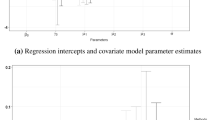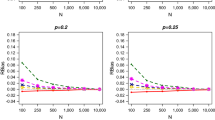Abstract
Closed capture-recapture (CR) estimators have been used extensively to estimate population size. Most closed CR approaches have been developed and evaluated for discrete-time models, but there has been little effort to evaluate their continuous-time counterparts. Continuous-time estimators — developed using maximum likelihood theory by Craig (1953) and Darroch (1958), and martingale theory by Becker (1984) — that allow capture probabilities to vary over time were evaluated using Monte Carlo simulation. Overall, the ML estimators had a smaller MSE. The estimators performed well when model assumptions were upheld, and were somewhat robust to heterogeneity in capture probabilities. However, the estimators were not robust to behavioural effects in the capture probabilities. Time lag effects (periods when animals might be unavailable for immediate recapture) on continuous-time estimates were also investigated and results indicated a positive bias which was greater for smaller populations. There was no gain in performance when using a continuous-time estimator versus a discrete-time estimator on the same simulated data. Usefulness of the continuous-time approach may be limited to study designs where animals are easier to sample using continuous-time methodology.
Similar content being viewed by others
References
Aalen, 0.0. (1978) Nonparametric inference for a family of counting processes. Annals of Statistics 6, 701–26.
Becker, N.G. (1984) Estimating population size from capture-recapture experiments in continuous time. Australian Journal of Statistics 26, 1–7.
Chao, A. (1989) Estimating population size for sparse data in capture-recapture experiments. Biometrics 45, 419–28.
Chao, A. and Lee, S.M. (1991) Estimating population size for continuous-time capture-recapture models via sample coverage. Technical Report 91-C-O1, Institute of Statistics, National Tsing Hua University, Taiwan.
Chao, A., Lee, S-M and Jeng, S-L (1992) Estimating population size for capture-recapture data when capture probabilities vary by time and individual animal. Biometrics 48, 201–16.
Cormack, R.M. (1968) The statistics of capture-recapture methods. Oceanography and Marine Biology; An Annual Review 6, 455–506.
Craig, C.C. (1953) On the utilization of marked specimens in estimating populations of flying insects. Biometrika 40, 170–6.
Darroch, J.N. (1958) The multiple-recapture census, I. Estimation of a closed population. Biometrika 45, 343–59.
Evans, M.A., Bonett, D.G. and McDonald, L.L. 1994 A general theory for modeling capture-recapture data from a closed population. Biometrics 50, 396–4055.
Hanski, I., Kuussaari, M. and Nieminen, M. (1994) Metapopulation structure and migration in the butterfly Melitaea cinxia. Ecology 75, 747–62.
Lee, S-M and Chao, A. (1994) Estimating population size via sample coverage for closed capture-recapture models Biometrics 50, 88–92.
Lincoln, F.C. (1930) Calculating waterfowl abundance on the basis of banding returns. U.S. Department of Agriculture Circular No. 118, 1–4.
Mace, R.D., Minta, S.C., Manley, T.L. and Aune, K.E. (1994) Estimating grizzly bear population size using camera sightings. Wildlife Society Bulletin 22, 74–83.
Menkens, G.E. and Anderson, S.H. (1988) Estimation of small-mammal population size. Ecology 69,1952–9.
Mood, A.M., Graybill, F.A. and Boes, D.C. (1974) Introduction to the Theory of Statistics. McGraw-Hill, New York.
Otis, D.L., Burnham, K.P., White, G.C. and Anderson, D.R. (1978) Statistical inference from capture data on closed populations. Wildlife Monographs No 62, Wildlife Society, Blacksburg, VA.
Pollock, K.H., Nichols, J.D., Brownie, C. and Hines, J.E. (1990) Statistical inference for capture-recapture experiments. Wildlife Monographs No. 107, Wildlife Society, Blacksburg, VA.
Seber, G.A.F. (1982) The Estimation of Animal Abundance, 2nd edn. Griffin, London.
Seber, G.A.F. (1986) A review of estimating animal abundance. Biometrics 42, 267–92.
Seber, G.A.F. (1992) A review of estimating animal abundance II. Reviews of the International Statistical Institute 60, 129–66.
Tanaka, R. (1980) Controversial problems in advanced research on estimating population densities of small rodents. Researches on Population Ecology Supplement 2, 1–66.
Venzon, D.J. and Moolgavkar, S.H. (1988) A method for computing profile-likelihood based confidence intervals. Applied Statistics 37, 87–94.
White, G.C. and Garrott, R.A. (1990) Analysis of Wildlife Radio-Tracking Data. Academic Press, San Diego.
White, G.C., Anderson, D.R., Burnham, K.P. and Otis, D.L. (1982) Capture-recapture and removal methods for sampling closed populations. LA-8787-NERP. Los Alamos National Lab., Los Alamos, NM.
Whitehead H. and Arnbom, T. (1987). Social organizations of sperm whales off the Galapagos Islands, February-April 1985. Canadian Journal of Zoology 65, 913–19.
Wilson, K.R. (1991) Capture-recapture population estimation in continuous time. Ph.D. thesis, Colorado State University.
Yip, P. (1989) An inference procedure for a capture and recapture experiment with time dependent capture probabilities. Biometrics 45, 471–9.
Yip, P., Fong, D.Y.T. and Wilson, K.R. (1993). Estimating population size by recapture sampling via estimating function. Stochastic Models 9, 179–93.
Author information
Authors and Affiliations
Rights and permissions
About this article
Cite this article
Wilson, K.R., Anderson, D.R. Continuous-time capture-recapture population estimation when capture probabilities vary over time. Environ Ecol Stat 2, 55–69 (1995). https://doi.org/10.1007/BF00452931
Received:
Revised:
Issue Date:
DOI: https://doi.org/10.1007/BF00452931




